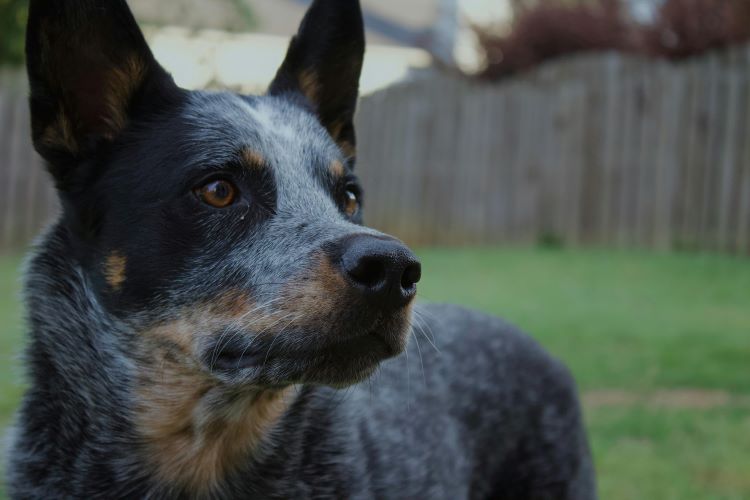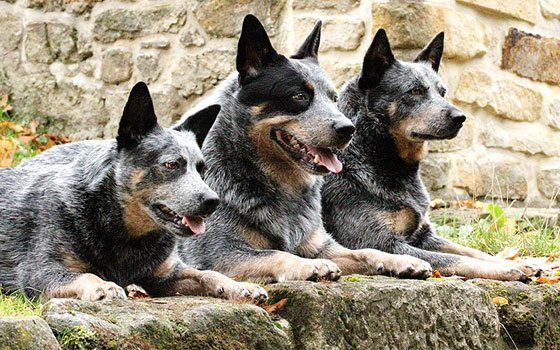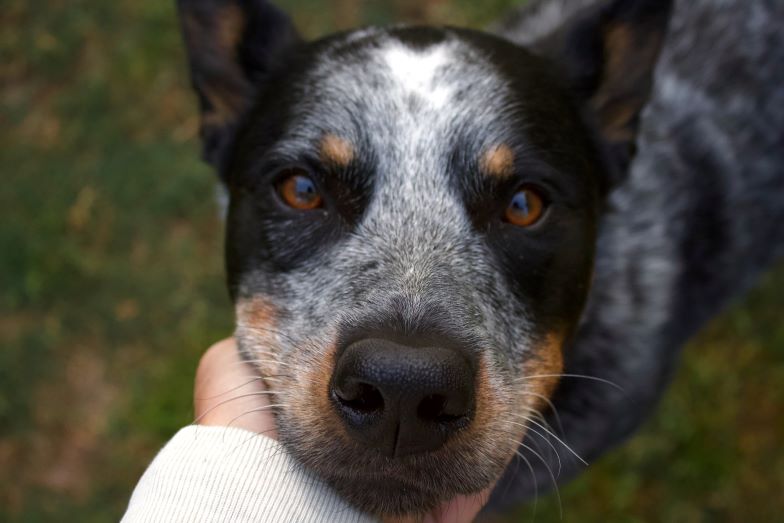Ready to help treat your pet to a healthy life?
A Guide to the Australian Cattle Dog, a.k.a. the Heeler Breed
By : Trupanion Staff | Updated Nov 15, 2024

Ever hear of a “Blue Heeler” or “Red Heeler” dog? What you're really looking at is the Australian Cattle Dog, a hardworking herding breed renowned for its loyalty and intelligence. Originally bred in Australia for driving cattle across vast, rugged terrains, this breed is both energetic and highly trainable, making it a favorite pet for active people and families who love the outdoors. And that's just the beginning! There's a lot more to these cool dogs than meets the eye. Whether you're considering which kind of dog breed to adopt or simply want to learn more about your current pet, we've put together this Australian Cattle Dog breed guide to answer all your questions.
We'll start with some cool facts about these dogs that make them unique. But skip on ahead if you want to get straight to their breed history, personality, health care tips, and more.
6 fun facts about Australian Cattle Dogs
In addition to being intelligent, there's a lot to admire about these dogs:
- This breed has many names! Officially named Australian Cattle Dog, they are also called Red Heelers, Blue Heelers, Queensland Heelers, Halls Heelers, and Australian Heelers.
- Australian Cattle Dogs come in two color varieties: blue and red. But puppies are born mostly white, with their eventual coat color starting to show around four weeks of age.
- According to Guinness World Records, an Australian Cattle Dog named Bluey was the Oldest Dog Ever. He was 29 years and five months old when he passed away in 1939.
- The Australian Cattle Dog has a cousin breed — the Australian Stumpy Tail Cattle Dog. The Stumpy Tail is considered a separate breed and is born with a naturally bobbed tail, compared to the Australian Cattle Dog, which has a long, undocked tail.
- Australian Cattle Dogs are a result of mixing imported herding breeds with Dingos. This mix gave them the endurance to drive herds of cattle for long distances over the rugged terrain of Queensland, Australia.
- These dogs have longer lifespans compared to a lot of other dog breeds, reaching between 12 and 16 years on average.
What is an Australian Cattle Dog exactly?
Also known as "Heelers," (or by their color-specific Heeler names) Australian Cattle Dogs are a type of herding breed originating from, you guessed it, Australia.
In terms of appearance, Heelers are athletic yet stocky-looking dogs with distinctive red or blue color coat patterns. These can be confused for a merle pattern seen on other breeds, but the truth is that it's quite unique. Cattle Dogs have what’s called “speckled” or “mottled” coloring. They also have a short double coat. You’ll see ACDs in two varieties: Blue or Red. The Blue Heeler coat is a mixture of black and white fur. The more black fur interspersed in the white, the “darker” the blue. Their coat patterns can be classified as either “mottled” or “speckled,” depending on whether they have large patterns of white dots throughout their coat or have more of a blended salt-and-pepper pattern.
Personality
Outdoorsy. Rugged. Loyal. Full of vigor. The Australian Cattle Dog is not for the faint of heart! Their endless energy is matched only by their dedication to their owner. While Heelers tend to be more reserved with people they don’t know, they are very affectionate with their family. This dedication to their people, alertness, and loud, high-pitched bark make them excellent watchdogs. Because this breed was created with the specific task of driving cattle over long distances, they are truly endurance athletes, with the intelligence to match. If you’re up for an active lifestyle full of adventure, a Heeler is a dog for the job!
Similar dog breeds
- Australian Kelpie
- Australian Stumpy Tail Cattle Dog
- Cardigan Welsh Corgi
- Australian Shepherd
- Border Collie

History of the Australian Cattle Dog
The Australian Cattle Dog is the result of the intentional crossing of different dog breeds to create the perfect cattle dog for the rugged Australian terrain. Cattle drovers desperately needed to move herds of livestock from their grazing lands to the market, hundreds of miles away. The herding dogs imported from England were not suited to the climate or the long journeys.
In the late 1820s, Thomas Hall of New South Wales crossed tamed Dingoes with smooth-coated merle collies. After a couple of decades refining his drover dogs, he had created the predecessor to the Australian Cattle Dog, known as Hall’s Heelers. These dogs were kept in the family until his death in 1870, contributing to their success in the cattle industry.
Once Hall’s Heelers were freely available to other ranchers, they also became popular with dog fanciers that wanted to focus on showing rather than working. This shift in the 1880s led to an official breed standard in 1903. Interestingly, this time in the Australian Cattle Dog’s history is debated. Many historians of the breed believe the Bagust family, prominent breeders of the time, crossed them with the Dalmatian and the Kelpie to create what we know as the modern Cattle Dog. Others argue this wasn’t possible based on the timeline. Some theories don’t include the Hall’s Heelers at all, instead claiming that George Elliot was the originator of the Dingo-collie crosses that would become the Cattle Dog. Whatever their lineage, Australian Cattle Dogs proved to be indispensable working dogs throughout Australia.
North American history
It was during World War II that Americans became familiar with the Australian Cattle Dog. Soldiers stationed in Queensland during the war fell in love with the breed and brought them home. While recognized as a member of the miscellaneous breed group since the 1930s, it wasn’t until 1980 that the American Kennel Club officially recognized the Australian Cattle Dog. They were ranked as the 55th most popular dog breed in the United States in 2018.
Heeler behavior and training
The Cattle Dog will love to work with you and enjoys a challenge. This industriousness means the breed might not be the best for first-time dog owners, as their physical and mental needs require quite the commitment. An Australian Cattle Dog has naturally high “drives,” or behavioral propensity and desire toward things like herding, barking, chasing prey, and other work. It’s what they were bred to do!
This breed should always have a job that fulfills these high drives. Otherwise, an energetic Heeler can become hyperactive, anxious, and exhibit problem behaviors. Cattle Dogs need lots of positive reinforcement training, physical exercise, and mental stimulation to support a well-balanced life. The Cattle Dog will thrive in activities such as agility, herding, or Treibball (Urban Herding), and other dog sports where they can put their instincts to work.
Do they get along with others?
Australian Cattle Dogs tend to be more reserved with people outside of their family and can be protective. Proper proactive exposure to new sights, sounds, people, dogs, and other animals as a young puppy is essential for their socialization skills.
Heelers are born to herd and drive cattle through nipping and barking. Cattle Dogs do best with older children in the home that don’t inadvertently encourage these herding behaviors with running and high pitched noises. Socialization as a puppy to younger children will help an Australian Cattle Dog learn how to interact with children appropriately but will not change their herding instincts. Young children and dogs should always be supervised, and it’s helpful for a dog to have their own “safe space” where they can go when they need some quiet time.

This breed can do well with other animals in the home if they are socialized as a puppy and properly introduced. However, Australian Cattle Dogs are known for being more attached to their people than to other pets in the home. Their herding instincts can make it hard for them to not chase after cats or other pets.
Exercise needs
Daily exercise is so important for this herding breed, and they do best with at least an hour of physical activity every day. Australian Cattle Dogs love adventure and getting out with their people. Their athleticism, agility, and endurance level make them excellent jogging or hiking partners, once they’re fully grown.
Speak with your veterinarian about appropriate exercise for a Cattle Dog puppy. Until they’re full-grown (bone growth plates typically all close around 12 to 18 months of age), avoid jogging or running beyond what they would do on their own. This limits the risk of damage to the growing bone and cartilage, which can cause pain and future joint issues.
Mental enrichment
Bolster your Cattle Dog’s physical exercise with mental exercise as well — this is a very intelligent breed that needs problems to solve. Focus their brains on training exercises and teaching new tricks. Provide puzzles and interactive toys, and give them lots of environmental enrichment to keep them positively engaged with their surroundings. Enrichment and brain games are especially beneficial for puppies and will help prevent unwanted behaviors, such as chewing and boredom barking.
Activities for Heelers
Australian Cattle Dogs do well in many different activities:
- Herding / Treibball
- Agility
- Nose Work
- Disc Dog
- Cart Pulling
- Skijoring
- Rally Obedience
Health and grooming tips
Overall, Australian Cattle Dogs are considered a healthy, lower maintenance breed. However, that doesn't guarantee they'll be free from harm. Work with your pet's veterinarian to establish a healthy diet and care routine for your pet. Keeping up with regular vet check-ups and daily exercise will also help promote their health and prevent issues. And while it may seem like an extra step, signing up for a good dog insurance plan is important for protecting your Heeler against unexpected illnesses and accidents throughout their lifetime.
10 common health conditions in Heelers
Like all dog breeds, Australian Cattle Dogs are prone to some health conditions more so than others. This does not mean they'll get sick, but it is important to be aware of the risks. The conditions commonly found in these pups include (but are not limited to) the following:
- Hip dysplasia — A genetic condition affecting hip joints, causing pain and mobility issues.
- Elbow dysplasia — Similar to hip dysplasia but affecting the elbows, leading to lameness.
- Progressive retinal atrophy (PRA) — A degenerative eye condition that can lead to blindness.
- Deafness — Congenital deafness is common, especially in Blue Heelers.
- Collie Eye Anomaly (CEA) — An inherited eye disorder that can cause vision problems.
- Osteochondritis Dissecans (OCD) — A joint disorder affecting cartilage growth.
- Hypothyroidism — A thyroid disorder that can lead to weight gain and lethargy.
- Dental disease — Common in many dogs, leading to gum infections and tooth loss. Keeping up with routine canine dental care is crucial because of this.
- Allergies — Prone to skin allergies, causing itching and discomfort.
- Urinary tract stones — Some Heelers develop bladder or kidney stones, causing pain and potentially serious urinary issues.
Grooming care
Even though the ACD has a double coat, it doesn’t require lots of work to keep in tip-top shape. The natural oil in the coat helps to slough off dirt and bad odors. Brush your Cattle Dog once a week to spread these oils throughout the coat and keep the skin healthy. Brushing might need to be done more frequently during seasonal shedding in spring and fall.
Bathing should be done as needed, but you don’t want to overwash the coat and strip its natural oils. Introduce your Cattle Dog puppy to the grooming experience from a young age to create a positive association and encourage calm behavior during bathing and brushing.
Best Brush for an Australian Cattle Dog: Undercoat rake, Pin brush

Australian Cattle Dogs in Pop Culture
As loyal and highly-trainable pups, Heelers are popular among celebrities and have also made numerous appearances in media.
Famous Owners of the Australian Cattle Dog
- Matthew McConaughey (Actor)
- George Strait (Singer)
- Mike Wolfe (Reality Star)
- Steve Earle (Singer)
- Owen Wilson (Actor)
- Bruce Pascoe (Author)
- Adrienne Mishler (Actress/Yogi)
Australian Cattle Dogs in Books, Movies and TV
- Max’s dog in Mad Max 2: The Road Warrior
- Jack and Ennis’s dogs in Brokeback Mountain
- Red dog in the movie Red Dog
